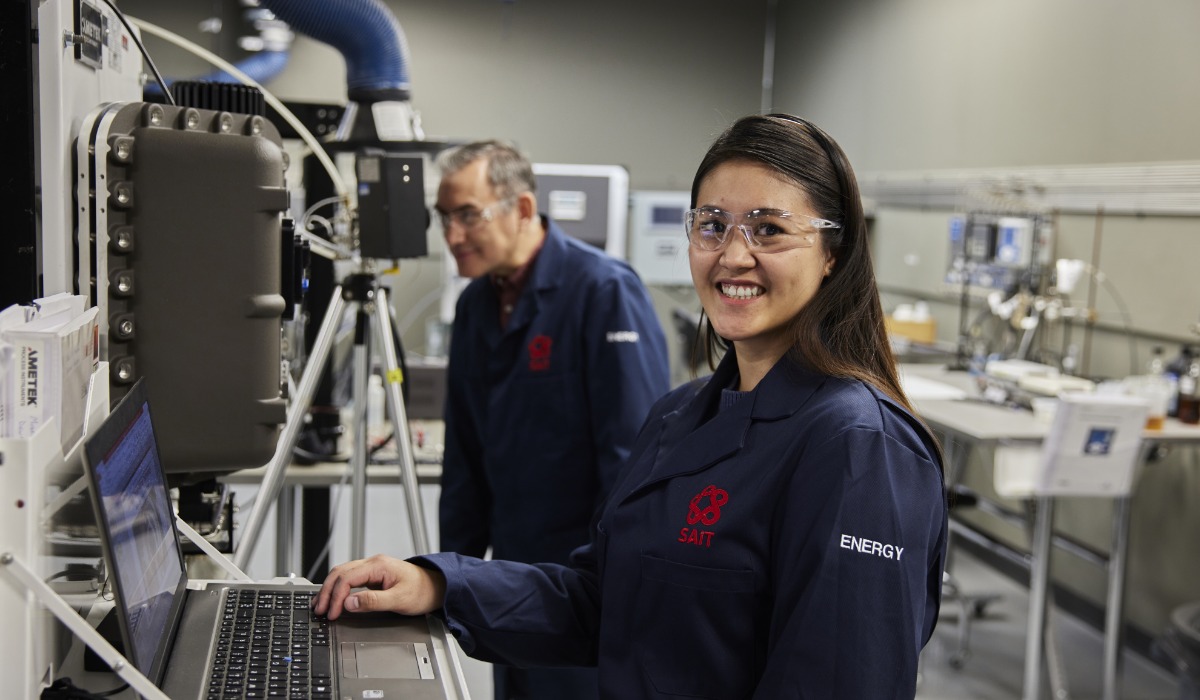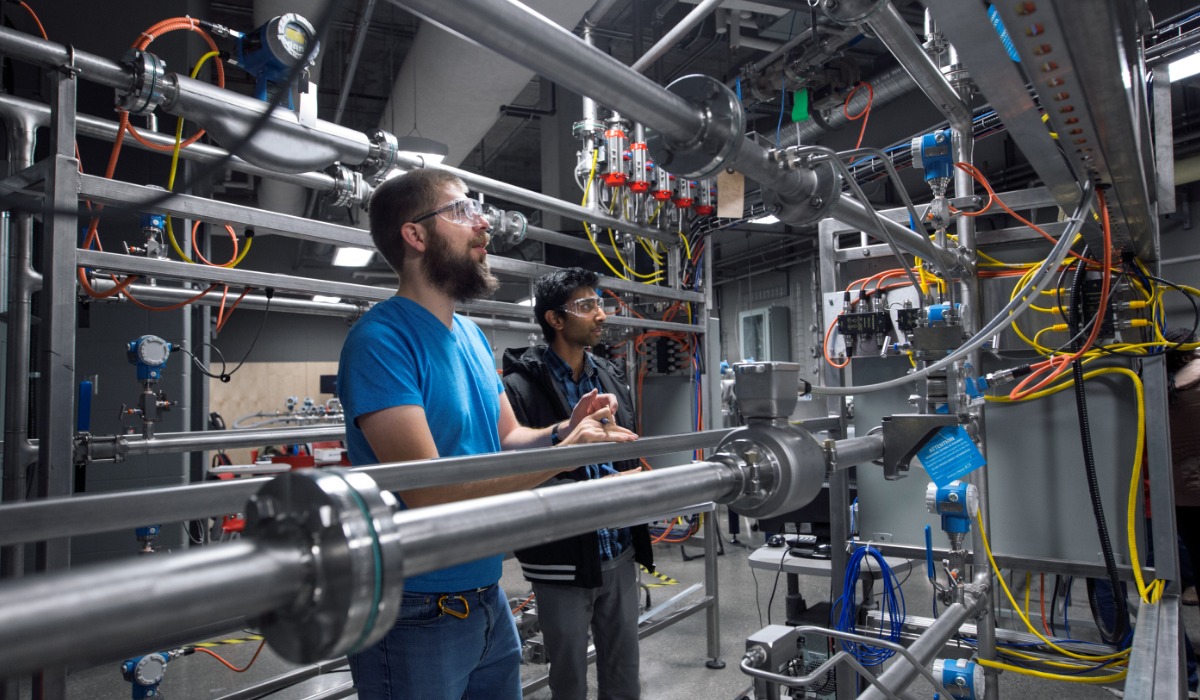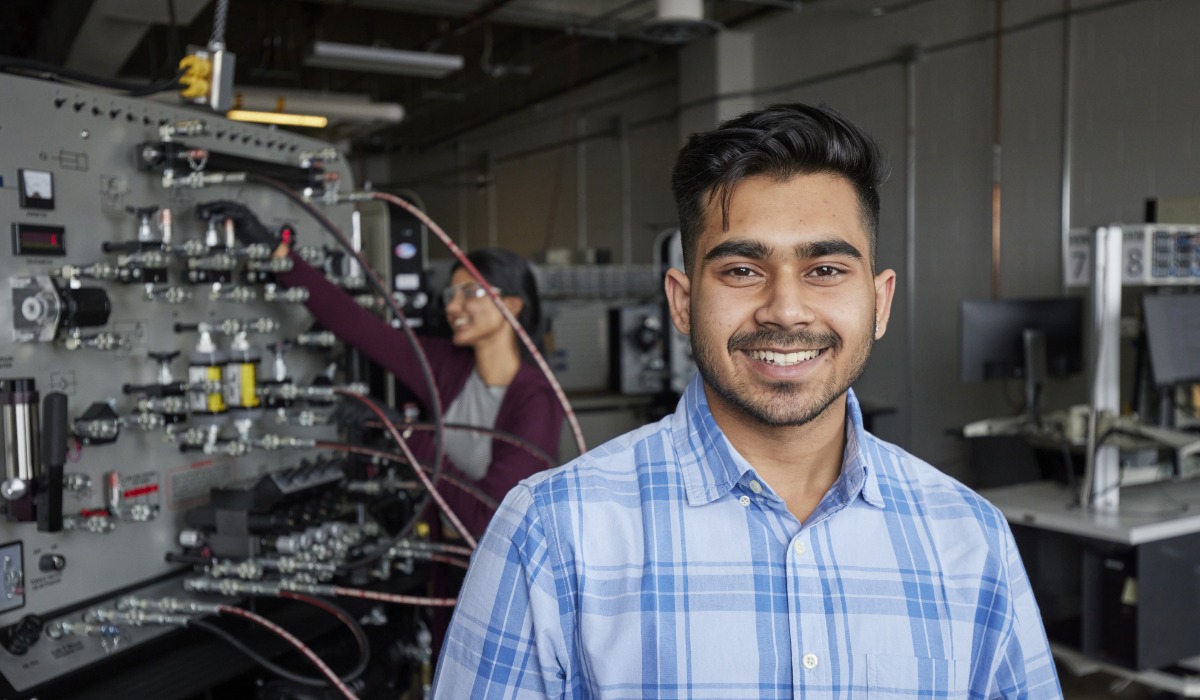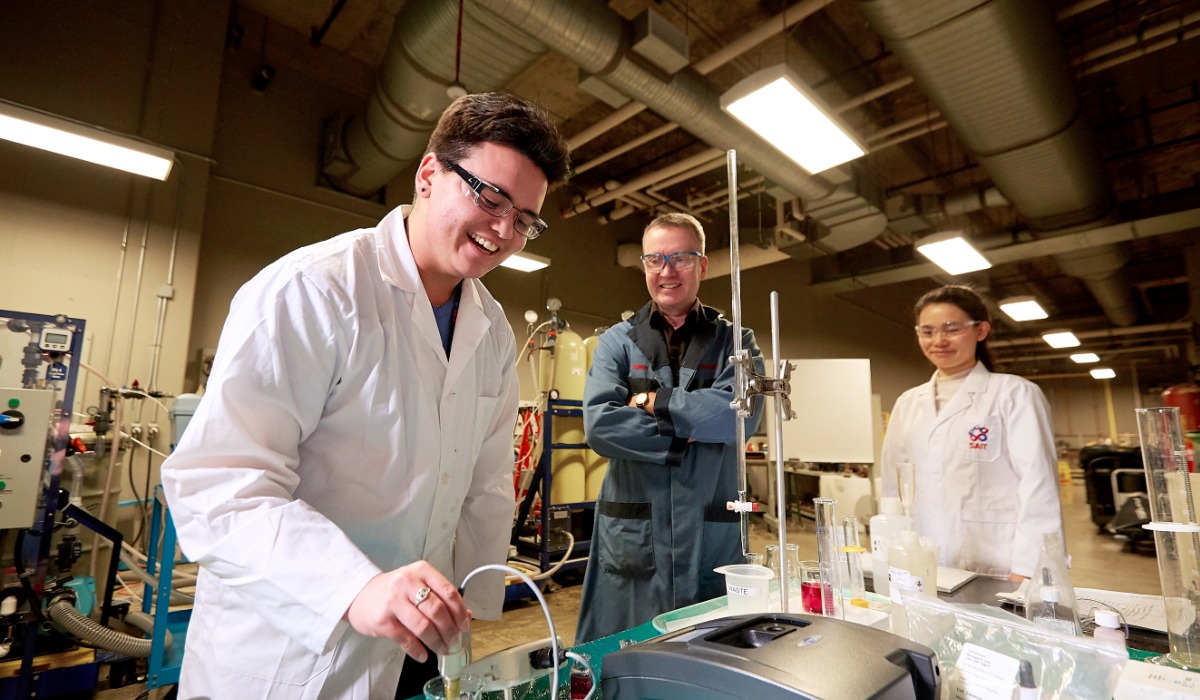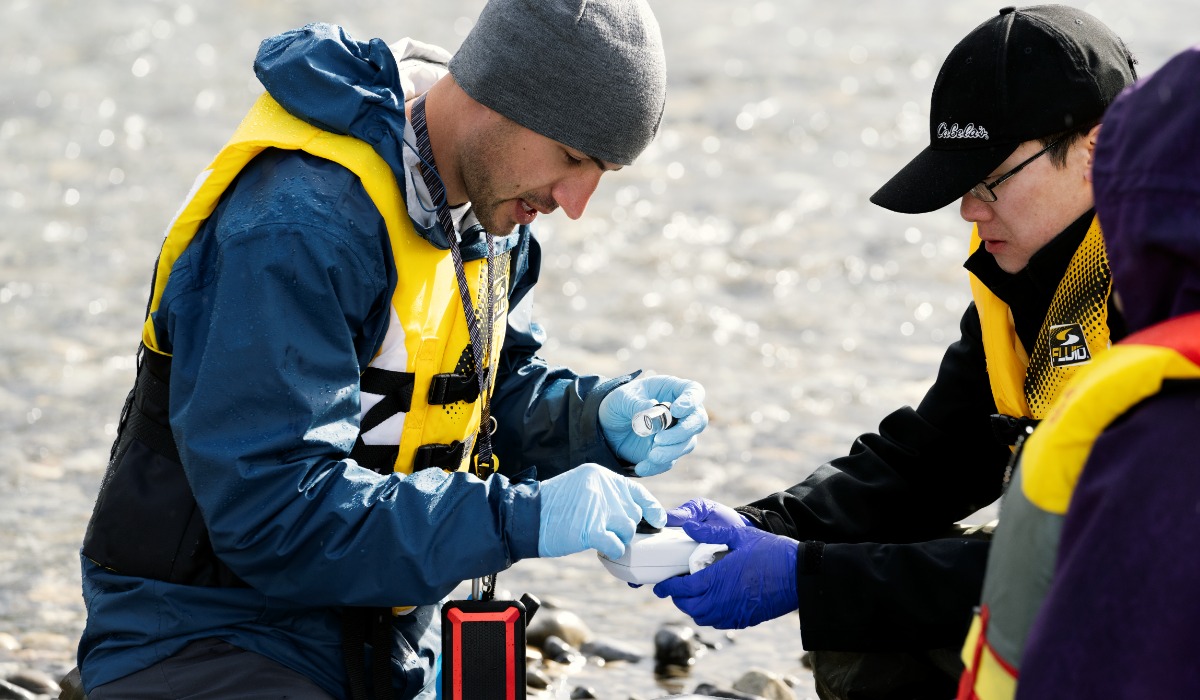Overview
The Instrumentation Engineering Technology program is designed to give you comprehensive theoretical and hands-on training in the operation and maintenance of automated process control and measurement systems.
Instrumentation and control engineering systems are essential in producing a range of commodities, offering various career opportunities.
In this program, you will:
- gain proficiency in managing automated process control systems that are pivotal in modern manufacturing and production
- acquire skills to install, troubleshoot, calibrate and repair electrical/electronic measurement and control instruments
- delve into pneumatic devices, control valves, electronic instruments, digital logic devices and computer-based process controls
- learn to design robust control systems, including Fieldbus™ SCADA, PLC and distributed control systems
- master interfacing industrial microcomputer control systems with actual processes for seamless operation
- carry out pilot-scale or trial-run processes within modern laboratory facilities, including a fully equipped control room
- become an adept technician in personal computer applications relevant to instrumentation and process control systems.
As a graduate, you can pursue a career in control engineering, engineering design, instrumentation sales and industrial process plants across sectors such as power production, oil and gas, fertilizer production, petrochemicals, food processing and more.
With an impressive employment rate for graduates, the program opens doors to a prosperous career in instrumentation and control engineering technology.
This program spans over two years, with each academic year comprising two 15-week semesters. It's offered exclusively full-time. We recommend attending an information session to learn more about the curriculum, meet instructors and understand the career pathways available after graduation.
Embrace the opportunity to become a skilled professional in a field integral to the efficiency and success of the industrial sector.
Those working in instrumentation engineering tend to be objective, innovative and methodical.
You need:
- aptitude in math, chemistry and physics
- the ability to visualize 3D objects from 2D drawings
- persistence
- speaking and listening skills
- people skills to work in teams
- hands-on mechanical skills to troubleshoot equipment in the field.
You should enjoy doing precise work, analyzing test results, finding innovative solutions and taking a methodical approach to your work.
You'll complete a capstone project to prepare you to work with all project elements, from managing and planning, to work breakdown structures and scheduling.
This program is nationally accredited by Technology Accreditation Canada (TAC) at the Engineering Technologist level.
Students and graduates are eligible to join the Association of Science and Engineering Technology Professionals in Alberta (ASET) and the International Society of Automation (ISA).
After successfully completing this program, you'll receive a SAIT Instrumentation Engineering Technology diploma.
Careers and opportunities
Each year, SAIT conducts a survey between February and April to determine the employment rate, salary and satisfaction of our newest SAIT alumni.
![]() 100% graduate employment rate
100% graduate employment rate
![]() $67,000 average starting salary
$67,000 average starting salary
Find out more about our graduate employment statistics >
Our graduates may work in the following occupations. Some careers require additional experience and education.
Associated National Occupational Classification (NOC) codes: 22301, 22312.
Career planning support
Unsure which career path is for you? Here are some recommended career planning resources to help you decide your future.
You can also head to Alberta alis for lots of information about careers in Alberta, including quizzes and labour market information to help you narrow down a path.
Finally, you can take our online career finder quiz, which can help narrow your options based on your current skills and interests.
Courses
The Instrumentation Engineering Technology diploma requires 60 credits (23 courses) to complete.
The program spans two years, with two semesters each year.
| Course | Credits |
|---|---|
|
You will learn the theory and operation of process analyzers. The focus of this course is on gas and liquid analyzers, as well as safety related monitors and detectors. Liquid analyzers as discussed in APSC 202 are reviewed. You will become familiar with the commissioning and calibration process of analyzers to meet various governmental and industry standards. Pre-requisites:
|
3 |
|
This course will provide a foundation in basic chemistry and physics used in the design and operation of analytical instrumentation. You will study a number of topics related to analytical instrumentation: Apply light behaviour and electrochemistry concepts to gas and liquid analysis. Study the importance of corrosion prevention as it relates to the application of instrumentation. Identify some common hydrocarbon chains and relate them to hydrocarbon refining and combustion. Study why sample handling is the root cause in over 80% of "analyzer problems". Introduce water quality measurement and its importance within water treatment processes. Explore gas detection devices as they are used for safety purposes. Equivalents:
|
1.5 |
|
The fundamentals of fluid mechanics and thermodynamics are explored and applied to problems encountered in industrial instrumentation applications. Topics include: viscosity, buoyancy, pressure, Bernoulli's equation, pumps, as well as phase behaviour, steam tables and heat transfer. Theoretical concepts are reinforced through related lab activities. Corequsites:
|
1.5 |
|
This course will prepare the student to configure an RTU (independent), use a host to configure the communications and registers of an RTU, poll an RTU and configure a host as a multi-slave to poll the configuration of an RTU. The course will also focus on how to configure a PLC (independent), use a host to configure the communications and registers of a PLC, poll a PLC and configure a host as a multi-slave to poll configurations of a PLC. Pre-requisites:
Corequsites:
|
3 |
|
This course will prepare the student for hardware and software configuration of an Emerson DeltaV Distributed Control System. This course continues from CMPN 337 and compares Ethernet to serial networks. The lab designs consist of DeltaV configuration of graphics and modules. The labs design an operator interface to communicate through simulations of a process. The theory will focus less on data communications and concentrate towards DCS applications and their architectures. Pre-requisites:
|
3 |
|
This course will prepare the student for hardware and software configuration of an ABB 800xA Control System. This course is a hands on course that will introduce some of the communication techniques used in industry. Concepts from new technology and existing technology will be discussed. The student will have the opportunity to analyze and demonstrate, using ABB/800xA DCS architecture, module types and application software. Pre-requisites:
Equivalents:
|
3 |
|
This course is an introduction to the control loop, modelling and simple feedback control. Topics include: Laplace transform techniques; modelling of simple processes; feedback loop architecture; characteristics of the loop and its functional blocks; feedback controllers, their modes, and applications. The steady state and dynamic responses of first-order elements and their effects on a feedback control loop is emphasized. Pre-requisites:
Equivalents:
|
3 |
|
The course is a continuation of CNTR 322. The control of common process variables and multiple control loops such as cascade, override and multivariable control loops are studied. More advanced control strategies using ratio and feedforward control techniques are introduced. Control schemes are applied to the control of compressors, boilers and distillation columns. Pre-requisites:
Equivalents:
|
3 |
|
This course is designed to develop technical writing and presentation skills to ensure workplace readiness. Students will learn how to evaluate communication situations, analyze documents, assess research sources and develop organizational skills to apply in their work. They will learn about and practice designing, formatting and writing a range of professional documents. Students will also develop confidence (through practice) in the development and delivery of effective and engaging presentations. Equivalents:
|
3 |
|
This applied computer course provides students with critical electronic communications, data and file management skills, along with a strong focus on using common productivity applications to format, calculate, analyze, visualize, and present or report data and information. Equivalents:
|
1.5 |
|
An introductory course in electrical principles, concepts and relationships; power and energy; circuit analysis; capacitance; magnetism and inductance. The labs supplement the theory by using lab connections and computer simulations to illustrate operational and analytical concepts. |
3 |
|
This course picks up from the basics learned in ELEC 256 and moves onto exploring practical concepts around working at hazardous locations, working with electrical enclosures, the basic elements of electrical installations and identifying issues around intrinsic safety. Core concepts that will also be explored are such things as basic alternating single and three phase currents, electric motor fundamentals and foundations of basic digital principles. The labs supplement the theory by using lab connections and computer simulations to illustrate operational and analytical concepts. Pre-requisites:
Equivalents:
|
3 |
|
Process Instruments I provides an exploration of the measurement of three (pressure, level, temperature) of the 'big four' processes. Topics in this course include: the language (terminology) of process measurement; the science of measurement (Metrology); how pressure, level, and temperature of a process are measured; along with the generation (transmitters) of pneumatic, electric, and digital signals. Learners will acquire experience with these measurement devices through hands-on laboratory exercises. Corequsites:
Equivalents:
|
3 |
|
The World of Instrumentation is a guided tour of instrumentation, an opportunity to create instrumentation drawings using software, a look at instrumentation documentation and an introduction to industrial processes and equipment operations. Course participants will discover the opportunities available to instrumentation graduates through industry speakers and tours. Corequsites:
Equivalents:
|
3 |
|
This course is a continuation of INST 202 with emphasis on the selection of instruments for industrial process measurements of pressure, level, temperature, and flow. Topics include installation, calibration, and maintenance of head type flow measurement instruments, linear type including magnetic, turbine, vortex, ultrasonic, positive displacement and mass flow meters, sizing, selecting and testing instruments, final control elements, and introduction to controllers. Pre-requisites:
Equivalents:
|
3 |
|
Visual Basic programming explores computer programming with respect to instrumentation applications. Programming techniques explored include flow-charts, pseudo-code, if...else statements, select...case statements, functions and Subroutines, the debugger and creating a macro in Microsoft Excel. Advanced techniques explored include looping techniques, arrays, data transfer and data acquisition. The second half of the term involves writing an application to interact with a P-only controller. Pre-requisites:
Equivalents:
|
1.5 |
|
This course gives the student both fundamental and hands-on experience in various applications used within Instrument Engineering Technology as well as applications used for managing projects. Pre-requisites:
Equivalents:
|
1.5 |
|
The objective of this course is to introduce new and emerging technologies to the Instrumentation student. As stated, the course is directed at New and Emerging technologies. Therefore, the content will be continually evolving and changing. Included in the course are Safety Instrumented Systems (SIS), Wireless Communication, and Directive 17 measurement standards and regulations. Pre-requisites:
|
3 |
|
This course enables the student to apply the basic knowledge of algebra and introductory calculus to resolve applied scientific and technological problems. Applications include linear motion, areas under curves, and volumes of revolution. Equivalents:
|
3 |
|
This course enables the student to apply advanced algebra, integral and differential calculus methodologies to scientific and technological applications. Topics include trigonometric and transcendental calculus, methods of integration, specifically integration by parts, by trigonometric substitution, and by use of tables. Applications include linear motion, areas under curves, volumes of revolution, centroids, moments of inertia, and program-relevant applications. Pre-requisites:
Equivalents:
|
3 |
|
This course is designed to give students hands-on experience in the safe selection and use of many hand and power tools used in the performance of their duties in industry. For experienced students, it provides a review of tool use and purpose; for inexperienced students, it provides basics in the use of tools. Safe working procedures are stressed as various tools and procedures are explained and performed. Pre-requisites:
|
1.5 |
|
This course will prepare the student in working with project elements, managing and planning a project, work breakdown structure and scheduling a project. The course will also focus on meetings, regulatory requirements, request a quote (RFQ), quality assurance and estimating. Pre-requisites:
Equivalents:
|
3 |
|
STAT 245 is an introductory course in data analysis for students in engineering technology programs. Students apply techniques to organize, display, analyze and report data. Outcomes include methods of descriptive and inferential statistics. Students will be exposed to software-based methods in laboratory sessions using industry-grade data. Some advanced topics of analysis are selectable toward the end of the course. |
3 |
Progression
You must attain a PGPA and/or a CGPA of 2.0 or better each semester and pass the prerequisite courses to progress through the program.
To qualify for graduation, you must pass all courses, attain a CGPA of 2.0 or better and complete course requirements within the prescribed timelines.
Review our grading and progression procedure >
Explore your options!
Some courses in this program are available through Open Studies. You can complete courses via Open Studies to get a head start on your education, reduce your course load once accepted into a credentialed program, or determine which career path best suits you before you fully commit.
You may also take courses for general interest or personal and professional development.
Admission requirements
Applicants educated in Canada
All applicants must demonstrate English language proficiency and meet the following requirements or equivalents:
- at least 60% in Math 30-1 or 75% in Math 30-2, and
- at least 60% in English Language Arts 30-1 or 75% in English Language Arts 30-2, and
- at least 60% in Physics 20, and
- at least 60% in Chemistry 20.
SAIT accepts high school course equivalents for admission for applicants educated outside Alberta.
All applicants who were educated outside of Canada must demonstrate English language proficiency and provide proof they meet the program admission requirements outlined above with an international document assessment. Find accepted educational documents and assessment options.
SAIT may also accept courses completed at certain international post-secondary institutions.
Academic Upgrading
Missing an admission requirement for this program? Upgrade your prior education to help you receive admission into one of SAIT's career programs.
English language proficiency
All applicants must demonstrate English language proficiency prior to admission, including students educated in Canada.
Transfer agreements
At SAIT, we have created transfer agreements with partner institutions to allow you to earn course credits toward your SAIT program based on your previously completed credentials.
Transfer Alberta search tool
Use the Transfer Alberta search tool to see all transfer agreements between Alberta post-secondary institutions (including those with the University of Calgary, Mount Royal University and Bow Valley College.)
Search transfer agreements in Alberta
Transfer options for graduates
When you have completed this program, you may continue your education at a partner post-secondary institution. These transfer agreements include partnerships within and/or outside of Canada.
Credits this program transfers to
- Available credits:
- 60
Graduates of this program are eligible to apply for the Electrical and Computer Engineering bridge program offered by Camosun College, provided all admission requirements are met.
Successful completion of this bridging program will qualify you to enter the third year of the Bachelor of Engineering in Electrical Engineering (January intake) at the University of Victoria. This degree is eligible for Professional Engineering (P.Eng.) designation.
- Available credits:
- 60
Graduates of this program are eligible to apply for the Electrical and Computer Engineering bridge program offered by Camosun College, provided all admission requirements are met.
Successful completion of this bridging program will qualify you to enter the third year of the Bachelor of Engineering in Computer Engineering (January intake) at the University of Victoria. This degree is eligible for Professional Engineering (P.Eng.) designation.
- Available credits:
- 60
Upon successful completion of this program, you can ladder into the third year of TRU's Open Learning Bachelor of Technology program, provided you meet the admission requirements.
- Available credits:
- 60
Upon successful completion of this program, you can ladder into the third year of TRU's Open Learning Bachelor of Technology: Trades and Technology Leadership program, provided you meet the admission requirements.
Available intakes
Fall 2026
Start dates:
- Domestic students: Waitlisted
-
-
Application deadline: June 30, 2026
-
- International students: Open
-
-
Application deadline: May 29, 2026
-
Winter 2027
Start dates:
- Domestic Students (apps open March 1, 2026): Closed
-
-
Application deadline: Oct. 23, 2026
-
- International students: Open
-
-
Application deadline: Oct. 9, 2026
-
Costs
2025/26 tuition and fees
The following costs are effective as of July 1, 2025.
The estimated total cost of tuition and fees is based on the suggested schedule of study. Following a modified schedule will impact the fees you pay per semester and may alter final costs.
Domestic students
The program total is based on the estimated amount you will pay if you enter this program during the 2025/26 academic year. The program total amount listed on your letter of admission may appear higher. This amount is your maximum tuition guarantee for the program. SAIT will not exceed this maximum, regardless of changes in tuition and fees between academic years.
Books and supplies are approximately $1,000 - $1,500 per full-time year.
This is a bring-your-own-device program with a standard computer hardware and software requirement. See the specific requirements on our computers and laptops page.
Find your booklist on the SAIT Bookstore's website. The booklist will be available closer to the program start date.
Can't find your program or course? The bookstore didn't receive a textbook list. Contact your program directly to determine if they're still refining course details or if you're in luck; no textbook purchase is required this term.
Required equipment/tools
You'll require a scientific calculator capable of performing linear regression.
Required personal protective equipment (PPE)
The industry-approved PPE you'll need will be discussed during your first few days of classes.
PPE is required in various labs. You'll need CSA-approved (green triangle) protective footwear and CSA Z94.3 (class 1) safety glasses with side shields.
Financial aid
Paying for your education may feel overwhelming, but we have resources and programs that can help, including information about payment options, student loans, grants and scholarships.
Application process
Ready to apply?
Follow our step-by-step guide to submitting a successful application.
Communication during admission
Email is the primary source of communication during the selection process. Ensure your personal email account is managed appropriately to receive our emails, files and communications. We recommend you add the macphail.students@sait.ca domain to your safe senders' list or you risk missing critical email messages.
Begin your application
Apply now using the online application portal.
Ensure you have a valid Visa or Mastercard to pay the non-refundable application fee of $120 for domestic applicants or $175 for international applicants.
Information sessions
Prepare for a strong start in your chosen program or get the details you need to decide your future path.
Our expert staff and faculty are ready to answer your questions and provide information about the following:
- What sets SAIT apart
- An introduction to the program and area of study
- Admission requirements
- Future career paths
- Information on the earning potential and graduate employment rates.
Contact us
MacPhail School of Energy
-
Phone - 403.284.8451
International Student Advising
-
Phone - 403.284.8852
-
Email - international@sait.ca
Subscribe for updates
Your journey starts here! Sign up to get important updates on:
- Energy and environment programs
- Application information
- Relevant news and events

Oki, Âba wathtech, Danit'ada, Tawnshi, Hello.
SAIT is located on the traditional territories of the Niitsitapi (Blackfoot) and the people of Treaty 7 which includes the Siksika, the Piikani, the Kainai, the Tsuut’ina and the Îyârhe Nakoda of Bearspaw, Chiniki and Goodstoney.
We are situated in an area the Blackfoot tribes traditionally called Moh’kinsstis, where the Bow River meets the Elbow River. We now call it the city of Calgary, which is also home to the Métis Nation of Alberta.
